

Auckland Water Shortage was foreseeable + Tips to save water: Don’t make it a drama, make it normal life. Despite warnings as early as spring 2019 from WeatherWatch.co.nz about a dry start to 2020 Auckland water restrictions are only now coming in to play in mid May 2020.
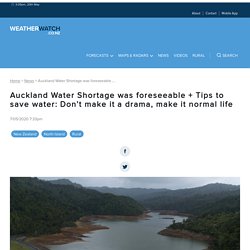
With Covid-19 already making so many changes to our everyday lives we thought we’d tackle this water shortage issue in a positive way – by framing it as “just another thing” to regulate slightly so we can all continue to enjoy supply. If everyone does a small part it all ads up. With many of us at home more now we’ll be using more water – just think about the extra dishes we have now, or the fact many of us can take a shower without the same time pressures. Watercare - Auckland's dam levels. Watercare akld water supply info 18may. Water and Sanitation – United Nations Sustainable Development.
While substantial progress has been made in increasing access to clean drinking water and sanitation, billions of people—mostly in rural areas—still lack these basic services. Worldwide, one in three people do not have access to safe drinking water, two out of five people do not have a basic hand-washing facility with soap and water, and more than 673 million people still practice open defecation. The COVID-19 pandemic has demonstrated the critical importance of sanitation, hygiene and adequate access to clean water for preventing and containing diseases. Why Water? - Water Changes Everything. We remove rubbish from the Sea, Harbours and Oceans.
Cube video captures the ocean’s plastic threat and designer’s solutions. As part of Design Insider’s MATERIALS series, cube video co-produced, shot and edited a documentary looking at how design can combat the plastic problem in ‘living with plastics’. the documentary depicts dismaying shots of divers in a sea of pollution and garbage-lined beaches in the UK. the desaturated tones and nostalgic music during the first couple minutes set the tone for the planet’s concerning and dire future relationship with the material. yet, the film interviews five professionals who may have the key for the issue. all images from cube video‘s MATERIALS ‘living with plastics’ documentary over the last few years, humans have been shown how bad the problem is with plastic pollution, and by 2050 it is widely reported that the amount of plastic in the sea will outweigh the amount of fish!
The film suggests there is a glimmer of hope, as demand for change begins to build. but how do designers come into the equation? How can they help make the use of plastic more responsible? LEARNZ: Sustainable Seas – essential for NZ`s health and wealth. LEARNZ and Sustainable Seas ran a successful field trip in Seaweek 2018 in Tasman Bay.
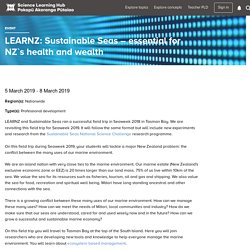
We are revisiting this field trip for Seaweek 2019. It will follow the same format but will include new experiments and research from the Sustainable Seas National Science Challenge research programme. On this field trip during Seaweek 2019, your students will tackle a major New Zealand problem: the conflict between the many uses of our marine environment.
We are an island nation with very close ties to the marine environment. Our marine estate (New Zealand's exclusive economic zone or EEZ) is 20 times larger than our land mass. 75% of us live within 10km of the sea. NZ teachers, enrol in this LEARNZ virtual field trip. Sunset over Kapiti Island - PixaBay - CC0.
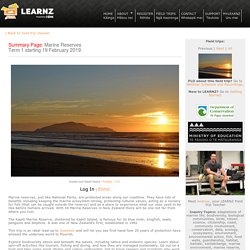
Log In | Enrol Marine reserves, just like National Parks, are protected areas along our coastline. They have lots of benefits including keeping the marine ecosystem strong, protecting cultural values, acting as a nursery for fish (that can be caught outside the reserve) and as a place to experience what our seas used to be like before humans arrived. Seaweek – Kaupapa Moana 2019. Boyan Slat: Why would you move through the oceans if the oceans can move through you? Curious Kids: How do plastic bags harm our environment and sea life? This is an article from Curious Kids, a series for children.
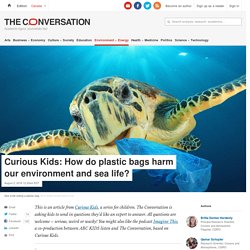
The Conversation is asking kids to send in questions they’d like an expert to answer. All questions are welcome – serious, weird or wacky! You might also like the podcast Imagine This, a co-production between ABC KIDS listen and The Conversation, based on Curious Kids. Andrea C. Alfaro - AUT. Professor of Marine Ecology and Aquaculture, Leader – Aquaculture Biotechnology Research Group Phone: +64 9 921 9999 ext 8197 Email: andrea.alfaro@aut.ac.nz Physical Address: Wakefield street WU307 WU Block, City Campus, Auckland CityPostal Address: Private Bag 92006 Auckland 1142 New Zealand (Mail No C-43) Links to relevant web pages:

The Jane Goodall Institute New Zealand. The Complicated Journey of Marine Plastic Pollution. The aim of this project is to raise awareness of the increasingly dire issue of marine plastic pollution and encourage people to participate in solutions.
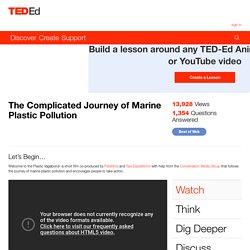
Find out more about the Tara Ocean Expeditions featured in the film. For a comprehensive report on The New Plastic Economy check out this recent report from the Ellen MacArthur Foundation. Read more about the Plastisphere--an entirely new ecosystem forming in the ocean due to the massive amounts of plastic trash. Check out Life in the “Plastisphere”: Microbial Communities on Plastic Marine Debris. Will the ocean ever run out of fish? - Ayana Elizabeth. Ocean solutions: This article pulls together the full spectrum of solutions to ocean challenges, with a handy graphic.

Jacquet et al. 2011. Scanning the Oceans for Solutions. Solutions.New models for sustainable, local seafood: Similar to community supported agriculture (CSAs) on land, community supported fisheries can deliver fresh seafood and ensure fishermen get a fair price – see, for example, Dock to Dish, which supports local fishermen and ensures traceability. The survival of the sea turtle - Scott Gass. Discover what makes a sea turtle so wonderfully adapted for the marine environment, gain a greater appreciation for the challenges they face, follow efforts to rescue and protect sea turtles both domestically and internationally, and uncover what you can do to help celebrate and preserve these amazing marine animals as you explore Saving a Species: Sea Turtles.

For a rich source of sea turtle information? Look no further than SeaWorld’s Sea Turtle InfoBook! Be waterwise booklet. Nature Is Speaking – Ian Somerhalder is Coral Reef. Nature Is Speaking – Harrison Ford is The Ocean. Nature Is Speaking: Penelope Cruz adalah Air. Curious Kids: How do plastic bags harm our environment and sea life? Forest and Bird. The islands of Aotearoa are some of the most remote in the world.

Their lonely place at the southern limit of the vast Pacific Ocean makes them an important place for marine species. Almost half of the world’s whales and dolphin visit or live in New Zealand waters — from the tiny Hector's and Māui's dolphins to the largest animal that’s ever existed, the blue whale. Aotearoa is also the seabird capital of the world. Of the 360 seabird species found worldwide, 86 breed in New Zealand, including 38 which breed nowhere else. But only a tiny fraction of our marine environment has any protection. Project Jonah New Zealand - Caring for whales, dolphins and seals. Mapping the future. In this activity, students use the Ake Ake model to explore changes that have taken place in their local environment in the last 50–100 years and to plan for the next 50 years.
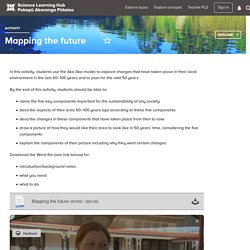
By the end of this activity, students should be able to: name the five key components important for the sustainability of any society describe aspects of their area 50–100 years ago according to these five components describe changes in these components that have taken place from then to now draw a picture of how they would like their area to look like in 50 years’ time, considering the five components explain the components of their picture including why they want certain changes. PETITION: Take action now to save Maui's dolphin. I urge the New Zealand Government to give proper protection to the critically endangered Maui's dolphin by: Extending their marine mammal sanctuary refuge to cover the dolphin's full habitat range; Banning net fishing, seabed mining, petroleum exploration and drilling from within the sanctuary; Banning seismic testing from within 20 nautical miles of the sanctuary's boundary.
New Zealand’s critically endangered Maui's dolphin is the world's smallest dolphin and it’s on the brink of extinction. Oil Spill Solutions. Lesson Focus Lesson focuses on how engineers use various techniques to provide speedy solutions to oil spills or other threats to natural water resources. Through this lesson, students work in teams to analyze an "oil spill" in the classroom, then design, build, and test a system to first contain, and then remove the oil from the water. Students select from everyday items to build their oil containment and clean-up systems, evaluate the effectiveness of their solution and those of other teams, and present their findings to the class.
Age Levels: Ocean cleaning machine: Australian surfers quit jobs, invent Seabin to clean up ocean - TomoNews. Volvo_keep_the_oceans_clean_pack_0.